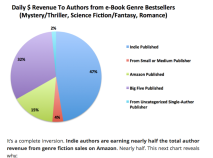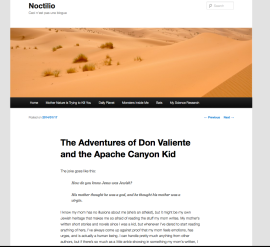I even made it onto three Amazon e-book bestseller lists
 I’ve never figured that paying a promotions company to market my book was a worthwhile investment of my money, but in the past month I’ve discovered – yet again – that when it comes to promoting books, I’m a neophyte.
I’ve never figured that paying a promotions company to market my book was a worthwhile investment of my money, but in the past month I’ve discovered – yet again – that when it comes to promoting books, I’m a neophyte.
After a few writer friends experienced success with a site called BookBub, I decided a few weeks ago that I’d give the company a try with Rita Just Wants to Be Thin. At the time, Rita was languishing at an average of about zero sales per week.
I was prepared to consider the $165 US or so that I thought a BookBub promo was going to cost me (for “worldwide” distribution of a book in the Women’s Fiction category) as money down the drain, but aside from the money ( ! ? ), I had nothing much to lose. I was curious. I figured it would at the very least provide me with the fodder for a post on this blog. As it has. But I never expected that I’d be writing such an enthusiastic review.
How BookBub Works
Millions of readers from all over the world have signed up at BookBub, and every day those readers are sent an email notification of one-day-only deep discounts on e-books in genres that interest them. Typically, e-books from publishers such as Random House and Penguin that normally sell for $11.95 are offered on BookBub for anywhere from $1.95 to $3.95. The e-books may be available through Amazon Kindle, Barnes & Noble, Apple iBooks, Google Play, etc. (Please note that BookBub promotes only electronic books [e-books] – not print books.)
Although BookBub subscribers get one notification per day of books that may interest them, not all readers are sent notifications about all discounted e-books. Notices go out only to those who are interested in that genre, and only to those in the geographic areas selected by the publisher. Books are individually approved by BookBub’s editorial committee before they are scheduled for promotion. Once your book is accepted, you are able to set up your author profile.
The cost to the publisher (me, in this case) of the one-day promotion of a book depends on its genre and the geographic area(s) selected, the choices being 1) USA, 2) International or 3) All. Every few months, BookBub adjusts its prices depending on the popularity of various categories, and on recent sales figures in different regions. There is a list of prices – and typical revenues – on the BookBub’s “partner” site.

For a few days, I was on Amazon bestseller lists in Canada, the US and Great Britain
(I just checked how much it would have cost to list Rita in the women’s fiction category for All regions today, and the price might have scared me off. It has gone up considerably since I started my BookBub adventure. So if the cost for your book’s category seems too high, wait: maybe it will come down again in a month or so.)
Why I Set My Price at Zero
Since the regular price of the e-book version of Rita is $2.99, and since Amazon won’t let me drop the price below $1.99 without my giving up the benefits of being in the Kindle Select program (which I don’t want to do), and since giving a book away for free on BookBub costs a whole lot less than selling it, I decided that I would offer my book as a giveaway. Amazon allows Kindle Select participants to give their books away for a maximum of five days every quarter.
I was pleased that my book was approved by BookBub right away. I was also pleased that they suggested a less expensive category (Chick Lit) than the one I’d chosen (Women’s Fiction). I don’t consider Rita to be chicklit, but I figured, what the hell: the cost savings was considerable.
I then stood back and waited to see what would happen.
Wow!
I was amazed.
On the day of the giveaway – July 5, 2016 – 19,159 people downloaded Rita for free! The following day, 740 more downloaded it for free (probably an international dateline thing). But more amazingly, on the day after the giveaway, nearly thirty people bought the ebook at its regular price of $2.99. The next day I sold eight copies, and I figured my moment of glory was done. But the day after that, I sold fourteen copies, and the day after that, 18. I’ve been selling e-copies of Rita ever since… at least one or two almost every day, and sometimes more. In addition, hundreds of people have read the book in the Kindle Unlimited library, and I get paid for those readers too.
One of the best results of the BookBub promo is that, since July 5, I have had nearly fifty reviews – most of them positive – on amazon.com, amazon.co.uk, and amazon.ca. I even had one review on amazon.au (that reviewer hated the book, but I’m sure the next reader from Australia is going to love it, just to balance things out). I’ve also noticed an uptick on my reviews on GoodReads.
Next?
I was hoping to do a promotion of The Adventures of Don Valiente and the Apache Canyon Kid on BookBub but my application was turned down. They say that sometimes they have too many books in a certain category already, and they invite publishers whose books are turned down to try again in four months. So I will do that.
 In the meantime, I’m going to try out a few other book-promotion platforms. Rita will be featured on StoryFinds on September 1, but without a price discount. I don’t expect anything like the BookBub response… but then, what do I know?
In the meantime, I’m going to try out a few other book-promotion platforms. Rita will be featured on StoryFinds on September 1, but without a price discount. I don’t expect anything like the BookBub response… but then, what do I know?
In the meantime, I highly recommend that both traditionally published and self-published authors check out BookBub. I’ve made my money back and more – and the reviews the promotion garnered were worth the investment all on their own.
While you’re at it, you might want to sign up at BookBub and StoryFinds to get some great deals on some great books.
_______________________
I invite you to share your thoughts on this or any other subject related to writing and publishing – either in the comments section below, or directly via email.
PLEASE NOTE: I will be away from email for one week (until August 24) so I will not be able to approve/post your comments until I return.





You must be logged in to post a comment.